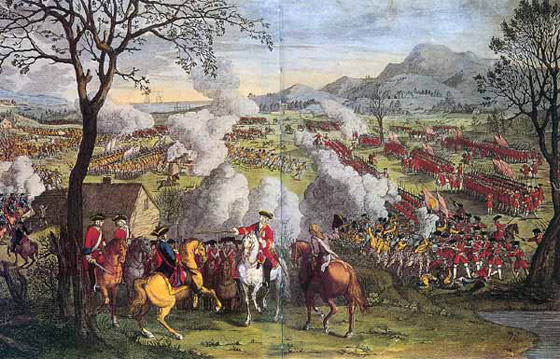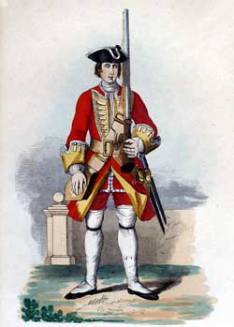|
In the summer of 1745 James Hallowell was a cadet under the command of Lord George Murray. On his eighteenth birthday he was commissioned an ensign of infantry. So it happened that on April 16, 1746 James was carrying the colors of the Athol Regiment at the disastrous battle on the Drumossie Muir near Culloden.

The Battle of Culloden
An artillery shell cut the ground from beneath James’ feet and tumbled him face down in the mud. Before he could rise, the advancing forces of the Duke of Cumberland overran his position and clattered on by, paying him no attention. When he tried to get to his feet to run away, he discovered that he was wounded in the right knee.
Sharing the little gully in which James found himself was the body of a redcoat private. James realizing that he was now far behind the advancing enemy line, stripped the corpse of its uniform and donned it himself. Picking up a musket to serve as a cane, he became apparently a wounded private soldier in Cumberland’s army.

Private in Cumberland's Army
His only ambition was only to get away from the battlefield as far as possible. So he fled the sound of the slaughter of the highlanders. This turned out to be not a good plan since it brought him to the area of Cumberland’s headquarters. He was soon accosted by a sergeant and told that since he was mobile, he should form up with a platoon of other soldiers separated from their units.
So James found himself traveling with the mop up platoon that was tasked with shooting the wounded Jacobite soldiers. Most of the men were glad enough to carry out the orders so James avoided actually killing any of his former comrades until Cumberland himself tried to get his general Wolfe to shoot a highlander who lay helpless on the ground scowling at Cumberland. Wolfe refused and Cumberland, seeing James nearby, ordered him to kill the man. There was no choice. After James shot the highlander he limped away dragging his gun behind a bush to be sick.
“Sergeant, bring me that man.” said the Duke of Cumberland. So the sergeant found James, dragged him to his feet and asked him his name and regiment. James was too sick and tired to lie so he said Ensign James Hallowell of Brighton, with the Athol Brigade. The sergeant, astounded, simply stepped back and whispered, “Spy.”
James in the instant of the sergeant’s hesitation swung his gun and knocked him down. At that time there was a commotion and a volley of gunfire from the vicinity of the Duke where an apparently dead highlander rose up and charged the Duke with his sword. James just turned his back on the uproar and walked away into the gathering dusk. That night he dragged himself in what he thought was a southerly direction until his path was blocked by the River Nairn. Turning downstream to the northeast he limped along until he found a dwelling.
James knew he had gone as far as he could without help. He was wounded and exhausted. Either this house held folks sympathetic to the Jacobite cause or he was a dead man. He stripped down to his underclothes and stockings, hiding the redcoat uniform and boots, and began to beat upon the cottage door.
Donald Blackmun was not asleep in the hours just before dawn. He had done a foolish thing the day before and was expecting retribution. The previous morning down at the pub a redcoat soldier was bullying Donald’s young nephew and Donald had beat the redcoat senseless. The publican ordered Donald out of the place and he fled to the riverside cottage he occupied with his wife Margaret. Hearing a beating on the door, Donald was expecting a squad of redcoats so he told Margaret to remain in bed and he slipped out the back and circled around through the woods to have a look.
When he saw that the disturbance was caused by a half naked teen-ager with a bloody right leg he emerged from the bushes and coming up behind James, clapped a hand on his shoulder saying, “Stop that Christless racket”. James collapsed in a heap as though Donald had clubbed him and Donald dragged him inside and shut the door.
By the time the sun was well up James had told his story to the Blackmuns, had his wound dressed and been fed. The next night Donald brought him down-river in a skiff to the village Nairn where he was placed by Jacobites of that town on a vessel bound for Copenhagen. From there he got word to his father in Brighton of his adventures.
During the time James was missing, Richard had been approached by the authorities concerning James’s whereabouts so when they heard James’s story they assumed he was being sought as a spy. Richard arranged for his passage to America under his mother’s maiden name. So it happened that in August of 1746 young James Wagg landed at Falmouth, Maine.
In the summer of 1746 Richard Crockett Jr. of Falmouth, Maine was a prosperous farmer who lived on the northwest side of the village. In late July the farm was raided by natives and his fourteen year old daughter Mary was captured and carried away. Word reached Richard that a group of prisoners was being held by the natives near the great falls on the Androscoggin River in preparation for transportation to Canada.
The military force at Falmouth had been reduced to the point that there were only six soldiers at Fort George so Richard determined to raise a force of volunteers to free the prisoners. That was why, when James Wagg came ashore in Cape Elizabeth on August 2, 1746 he saw a poster requesting able bodied men to report to Richard Crockett Jr. of Falmouth before August 5 for the purpose of rescuing a member of his family from the natives.
James had heard of the North American savages but had no real notion of what was going on. He simply thought that this would be a good way of making some acquaintances around Falmouth.
So James Wagg was one of the nineteen men who marched with Richard Crockett to Pejepscot where they received guns, ammunition and provisions from the fort. James was the only one of the company with any military training so at the age of eighteen he found himself in charge of the tactics for rescuing an unknown number of prisoners from an unknown number of natives.
James established a single file with a scout to the front, rear and both sides. The pace was set by the advance scout. The main body was to remain just within sight of him and the remaining scouts were to take their positions relative to the main body. In this way they came upon the native camp to find only four prisoners, Mary among them, guarded by five warriors and several women. The remaining warriors were evidently off on another raid.
James positioned the men around the camp with instructions to shake the bushes on his command walked into the camp unarmed. There he established communications with a fellow who spoke excellent English and demanded that the prisoners be released to him. When the warriors laughed at him he gave the command and the underbrush all around the camp began to rustle.
“Show me your guns”, the warrior said.
“Half you men stand up”, said James.
As pre-arranged, every man stood and leveled his gun at the people in the camp.
Richard and another man took the former prisoners down the river in the two canoes found at the native camp, along with all the native weapons. James and the other men marched back to Pejepscot and then back to Falmouth.
Richard was delighted with James’s part in the rescue and kept him on at the farm to learn the business and help out. It was nearly inevitable that James and Mary would marry, and they did in 1749. After several miscarriages Mary produced a son, James, in 1754 at the farm in Cape Elizabeth on the 100 acres granted James by Massachusetts for settling in Maine.
In 1755 the native troubles were essentially over and James moved his family to Danville, not far from where he had rescued Mary 13 years before. Land prices were high in Cape Elizabeth and low in Danville so the move left James with a handsome profit. The rich river valley soil made farming attractive and James lived the rest of his days by trading in land and doing a little farming himself.
James Sr. died in 1780 and was buried in the Old Wagg Cemetery, Auburn, ME. Mary lived with her son James and his wife in Danville until Mary’s death in 1791.
|




